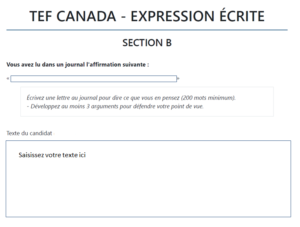
Publié le 15 April 2021
If you are taking the TEF and would like to prepare for section B of the written expression test, then this article is for you!
 The objective of section B is to express your point of view and you have 35 minutes to do so.
The objective of section B is to express your point of view and you have 35 minutes to do so.
According to the statement, you will have to write a text explaining why you agree or disagree, giving arguments and examples.
This section is also known as the “letter” test. However, the term “letter” is not adequate.
In fact, it is not mandatory to write your argumentation in the form of a letter.
To save time and efficiency, we recommend that you start with a simple introductory sentence. Here are some examples to inspire you:
|
To prepare yourself, you can consult the tutorial and the preparation workshop dedicated to the written expression test (in French).
During section B of the written expression test, you will be evaluated based on:
• the relevance of the information you transmit (are they in line with the subject?);
• the quality of the information (examples, details, illustrations);
• the overall coherence of the text;
• the quality of the sentences and the vocabulary you use (variety, precision);
• the syntax and punctuation.
|
1. There is no need to write a formal letter, with an official letterhead: it does not earn any points. |
You will have to take section B of the written expression whether you are taking the TEF, TEF Canada, or the TEFAQ.
| TEF, TEF Canada, TEFAQ |
| Duration of the test: 60 minutes |
|
Composition of the test:
|
You can also consult our articles on the TEF test:
–Prepare section A of the written expression test of the TEF
–Prepare for the oral expression test of the TEF
–Prepare for the written comprehension test of the TEF
–Prepare for the oral comprehension test of the TEF
–Prepare for the vocabulary and syntax test of the TEF
Don’t forget to consult our TEF preparation workshops here.
If you have further questions about the test preparation, email us at francais@cci-paris-idf.fr or join our Facebook group.